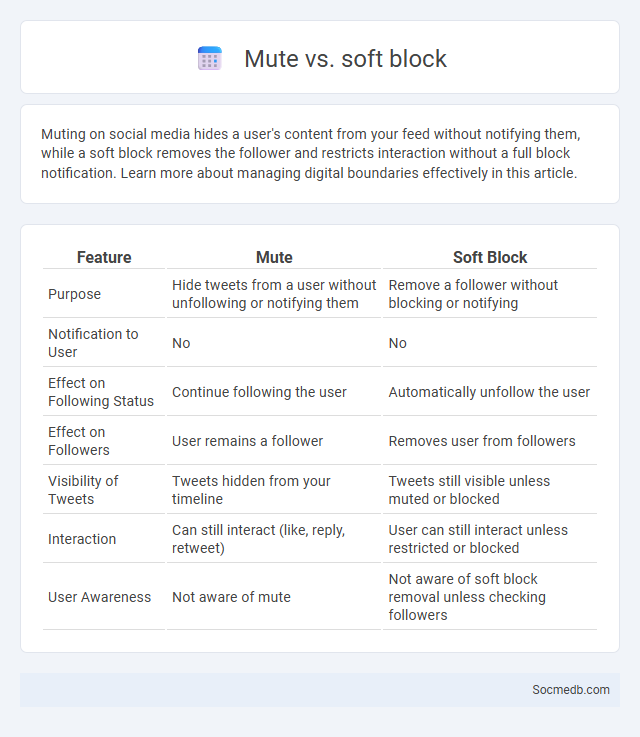
Photo illustration: mute vs soft block
Muting on social media hides a user's content from your feed without notifying them, while a soft block removes the follower and restricts interaction without a full block notification. Learn more about managing digital boundaries effectively in this article.
Table of Comparison
| Feature | Mute | Soft Block |
|---|---|---|
| Purpose | Hide tweets from a user without unfollowing or notifying them | Remove a follower without blocking or notifying |
| Notification to User | No | No |
| Effect on Following Status | Continue following the user | Automatically unfollow the user |
| Effect on Followers | User remains a follower | Removes user from followers |
| Visibility of Tweets | Tweets hidden from your timeline | Tweets still visible unless muted or blocked |
| Interaction | Can still interact (like, reply, retweet) | User can still interact unless restricted or blocked |
| User Awareness | Not aware of mute | Not aware of soft block removal unless checking followers |
Understanding Social Media Interaction Controls
Social media interaction controls such as likes, comments, shares, and privacy settings shape user engagement by regulating the visibility and reach of content. Algorithms prioritize posts based on these interaction metrics, influencing the content users see on platforms like Facebook, Instagram, and Twitter. Understanding these controls enables users and marketers to optimize content strategy and enhance audience interaction effectively.
What is Mute?
Mute on social media refers to the feature that allows users to hide posts, stories, or updates from specific accounts without unfollowing or blocking them. This tool helps maintain a curated feed by reducing unwanted content while preserving social connections and notifications. Platforms like Twitter, Instagram, and Facebook offer mute options to enhance user control over their online experience.
Definition of Soft Block
A soft block on social media occurs when You temporarily restrict someone's access to your profile by blocking and then immediately unblocking them. This action removes the person from your followers and prevents them from viewing your content or interacting with your profile without permanently banning them. Soft blocking serves as a discreet way to reset interactions and control who can follow or engage with Your online presence.
The Purpose of Blocking
Blocking on social media serves as a critical tool for users to protect their privacy and mental well-being by preventing unwanted interactions or harassment. It effectively restricts certain accounts from viewing your profile, sending messages, or engaging with your content, thereby creating a safer online environment. This feature empowers users to control their digital experience and maintain personal boundaries across platforms like Facebook, Instagram, and Twitter.
Key Differences: Mute vs Soft Block vs Block
Mute temporarily hides posts from specific accounts without notifying the user, allowing You to maintain connections discreetly. Soft Block removes the connection by unfollowing and blocking simultaneously but allows easy reconnection later, often without permanent restrictions. Block completely severs interaction, preventing any communication or content visibility, ensuring total privacy and control over your social media experience.
Pros and Cons of Muting
Muting on social media allows You to reduce exposure to unwanted content without unfollowing or blocking, maintaining relationships while avoiding negativity. It improves mental well-being by minimizing stress from frequent or irrelevant posts, creating a more personalized content feed. However, muting can result in missing important updates or conversations, potentially leading to social disconnect or misunderstandings.
When to Use a Soft Block
Use a soft block on social media to discreetly remove followers without notifying them, ideal for managing unwanted interactions while maintaining privacy. It helps reset connections by unfollowing users and preventing them from seeing your content without alerting them to the block. This strategy is effective for handling acquaintances or persistent followers without escalating conflicts.
Social and Emotional Impacts
Social media significantly influences emotional well-being by amplifying feelings of connection and isolation simultaneously. Your engagement can trigger dopamine release, fostering short-term happiness but also potential anxiety or depression from comparison and cyberbullying. Awareness of these social and emotional impacts helps manage online interactions for healthier mental health outcomes.
Privacy Considerations for Each Method
Social media platforms present varying privacy considerations, with users needing to manage tailored settings to control data visibility and sharing. Direct messaging ensures more private communication but depends on encryption protocols to protect information from unauthorized access. Public posts require users to be cautious about personal data exposure, as information shared broadly can be accessed by third parties and used for targeted advertising or data mining.
Choosing the Right Approach for Your Needs
Selecting the right social media strategy hinges on understanding your target audience's preferences and behavior patterns across platforms like Instagram, Facebook, and LinkedIn. Tailoring your content type--be it videos, articles, or images--to the platform increases engagement and boosts brand visibility. Your success depends on aligning your approach with specific business goals, such as lead generation, brand awareness, or customer service.
 socmedb.com
socmedb.com